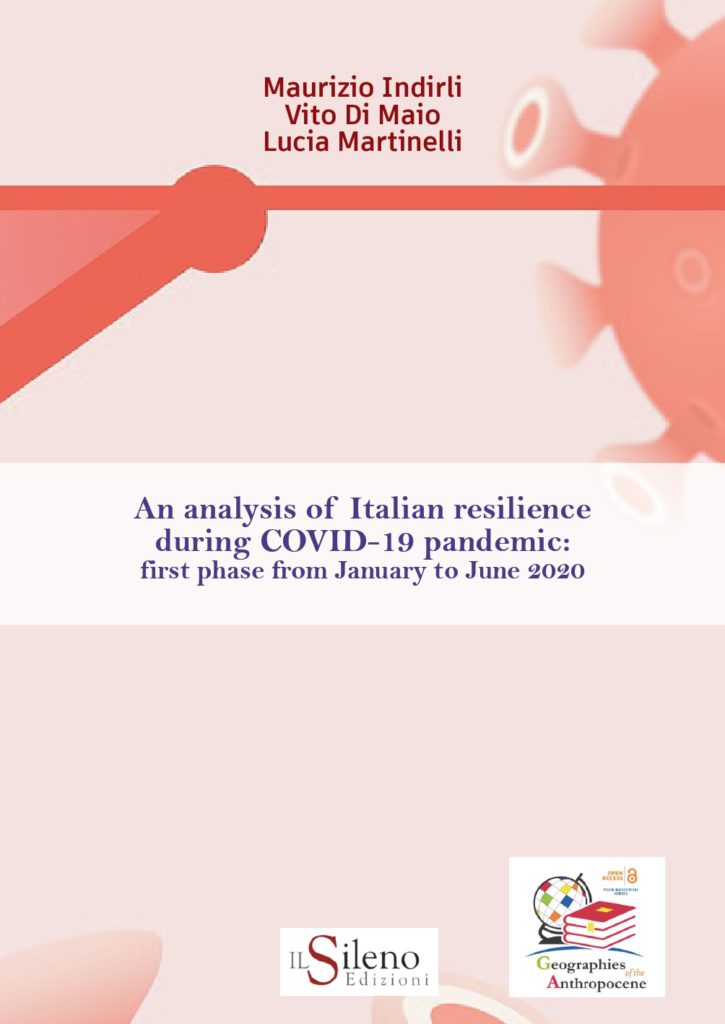Pubblicato il libro sulla resilenza italiana al covid-19 durante la prima fase della pandemia. Il libro, edito da ilSileno, scritto in collaborazione da Vito Di Maio (ISASI) con Maurizio Indirli (ENEA, Bologna) e Lucia Martinelli (MUSE, Trento). Il libro analizza la capacità di resilienza Italiana e delle singole regioni formulando indici di performance ed evidenziando importanti fattori legati all’elevata mortalità da covid riscontrata durante la prima fase dell’epidemia.
Year: 2021
Pages: 310
Language: English
Format: e-book
Publication: September 2021
Download e-book: https://www.ilsileno.it/edizioni/wp-content/uploads/2019/10/IDMM_IlSileno-Edizioni.pdf
The book gives a large view on the Covid-19 pandemic. Then the analysis is focused on Italy and a basic evaluation of Italian resilience is discussed.
Abstract
This work adopts the concept of resilience and its attributes (safety, robustness, adaptive capacity, sustainability, governance, and anamnesis) developed in a previous work (Indirli, 2019) to analyze the COVID-19 pandemic, with specific reference to Italy during the first phase, from January to June 2020. The aim is at assess the main features of this pandemic and suggesting a suitable tool to evaluate the capability of the Italian system to manage such catastrophe. Before discussing the Italian situation, a general overview about the current COVID-19 outbreak is presented, with special focus on selected countries worldwide, which adopted different intervention strategies such as exclusion, elimination, suppression, mitigation, and no substantive strategy.
With regard to Italy, an in-depth overview of the first COVID-19 phase (January – June 2020) is provided, together with detailed original lethality studies ad hoc developed. The evaluation of the resilience’s attributes is based on index values ranging from 1 to 5, using the Likert scale. A Global Resilience Index (GRI), suitable to provide a sense of direction (built or reduced resilience) is calculated, resulting for Italy 2.50, i.e. between poor (2.0) and medium (3.0), but far from very good (5.0). The pointed-out unpreparedness (a non-updated pandemic plan, almost forgotten before the COVID-19 crisis), inexperience (the absence of serious outbreaks in recent years), and inadequate timing (delayed decisions between February and March 2020) are discussed as main sources of such low resilience score. The Italian approach (as many other Western countries) shifted from denial to normalization of the risk, under-reaction, and finally to recognition and reframing. Worth stressing, healthcare system’s response, analyzed under safety and robustness, resulted weak especially at the outbreak beginning due to institutional International and National drawbacks and intrinsic vulnerability aggravated over time, despite the commendable efforts of the entire personnel. Furthermore, anamnesis and sustainability resulted dramatically low, while adaptive capacity and governance resulted a little bit better, mainly due to the lockdown phase and people’s behavior during the confinement.
In conclusion, the Italian performance against COVID-19 represents an example of “un-resilience”, i.e. a situation where emergency-after-disaster replaces prevention-before-disaster, as already shown in the case of other important hazards, such earthquakes, for example. This lack of resilience is therefore a tragedy itself, considering the fact that big crises are hitting the whole world more and more frequently and hardly, intermingling political, economic, social, technological, regulatory, and environmental issues. In this context, the COVID-19 pandemic is impacting every aspect of the human and the planet existence, not only peoples’ health and wellbeing.
This pandemic is also calling into question some assumptions of the democratic societies. We wish that COVID-19 pandemic would be a lesson able to push governments and citizens to be better prepared against possible emergencies of the future, many of which related to climate changes. A proactive action from public health agencies is urgent to protect populations, adopting a sustainable behavior in time of global warming and COVID-19 pandemic in all the human activities. Humanity has short time to operate effective choices and COVID-19 has been a hard test.
Indeed, in our analysis comes again the fork (Indirli, 2019) between ‘engineering resilience’ (homeostatic) and ‘ecological resilience’ (autopoietic) described at the starting point of this paper: will the humanity be able to govern the next changes or shall withstand a new mass extinction, leading to a drastic collapse of the Earth biodiversity? Our analysis focused on the pandemic outbreak that is still ongoing, not yet resolved and expected to be long and complex. Therefore, it is not yet possible to provide decisive answers to this question. However, we believe we have identified a useful tool to evaluate the system’s resilience to the present crisis and be prepared for possible future ones. It will be interesting to apply our methodology to the subsequent COVID-19 pandemic phases, to evaluate the effectiveness of the measures adopted, including the impact of the vaccination campaign.
Keywords
Resilience, COVID19 pandemic, SARS-CoV-2 pandemic, multi-hazard scenarios, multilevel networks, socio-ecological and sustainability systems, risk management.


